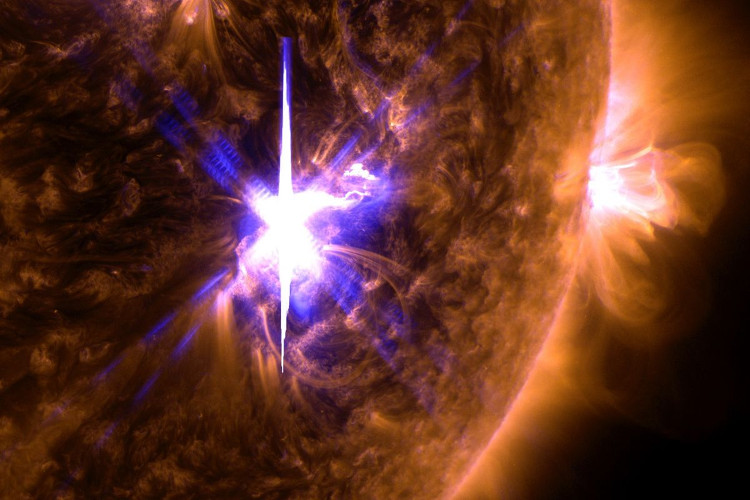Anxiety about an unusual sun
A direct attack on the earth can cause losses of up to $ 2,000 billion.
Some recent rare occurrences on the sun have caused scientists to not find an explanation. What is happening to the sun and should we be afraid of unusual phenomena on it?
A strange phenomenon
The US Agency for Aeronautics and Space (NASA) last month published a picture of a rare phenomenon known as "curled material" near a "hole" in the sun. This physical fiber surrounds an active area on the sun's surface. Typically, these black matter fibers appear with elongated shapes, so their curling up into each other has caught the attention of the scientific community.
"This is one of the few times we observed the circular material shaped like a rod, although it may not have significant scientific value," NASA officials noted.
This is not the only strange event happening on the sun over time. Earlier, in September, phenomenon 2 appeared on the surface of the sun also made the scientific community particularly worried and concerned. The size of many times the earth, these two sunspots - named after RGN 2673 and RGN 2674 - can be observed from the earth without using telescopes, according to the Ocean Administration. and the US national atmosphere (NOAA). As areas with strong and complex magnetic fields, RGN 2673 and RGN 2674 have created solar halo and fire, impacting communications, global positioning system (GPS) and radio signals. .

A huge solar flare was recorded on September 6.(Photo: NASA).
Black marks or fire circles or solar storms are not strange phenomena. Usually, they tend to appear most at the peak of the solar flare in the 11-year cycle. The current cycle of the sun, beginning in December 2008, shows that its activity intensity has plummeted and is about to enter the weakest outbreak. As expected, the sun will be the quietest at this stage. However, the events taking place in the past have shown the opposite, making scientists both excited and anxious because they do not expect to see the sun work strongly at that time.
Negative impact
Not only does it constantly appear at an unexpected time, the sun's fire also causes scientists to worry about their size and intensity. On September 6, the sun launched two X-level fire halves (the strongest level) that lost radio signals on the earth. In particular, the second fire halo is considered the strongest intensity recorded since 2005, causing an impact on the operation of satellites, communication systems and electricity on earth, according to Space Weather Prediction Center (SWPC).
The above solar activities have caused some radiation storms in high latitudes of the earth, disrupting radio communications at certain frequencies. According to The Conversation, their impact also spreads to the equator and affects high-frequency communications, such as amateur radio used in emergency response and disaster relief. Data from the Australian Bureau of Meteorology show that high-frequency radio communications seems to be disrupted in raging Irma storms.
Also in these areas, communication through the global satellite navigation system (GNSS) seems to be broken. Radiation storms also force flights through the polar regions to change routes to avoid an increased radiation environment that could adversely affect human health and threaten to damage the navigation system and related information. touch of the plane.
Meanwhile, CME formed from level X sunfire when exposed to the earth also threatens to cause other impacts on the near-earth space environment, including geomagnetic storms (still called magnetic storm). This storm is known for its potential to adversely affect satellites, earth communications technology, grid electricity, GPS / GNSS, and predict the satellite's orbit as well as fragments in the Universe. cylinder.
The scientific world cannot explain everything that happens on the sun. However, what happened last time signaled important spatial weather events that could take place at any time during the sun's 11-year cycle, even at the time it was thought to be quiet. most static.
- Worried about the higher IQ?
- 8 most unexpected advantages of anxiety
- Anxiety doubles the risk of death from cancer in men
- Research shows the unexpected benefits of anxiety
- 7 psychic powers of sufferers with anxiety disorder
- Explain the cause of many abnormal deaths
- Being anxious, the male faction easily lost their jobs to women
- Is there a mate or anxiety? Easy to die soon
- Panic disorder is what disease?
- Bacteria in the soil help reduce anxiety
- Breathing deeply helps to reduce anxiety and stress
- The source of fear
 Van Allen's belt and evidence that the Apollo 11 mission to the Moon was myth
Van Allen's belt and evidence that the Apollo 11 mission to the Moon was myth The levels of civilization in the universe (Kardashev scale)
The levels of civilization in the universe (Kardashev scale) Today Mars, the sun and the Earth are aligned
Today Mars, the sun and the Earth are aligned The Amazon owner announced a secret plan to build a space base for thousands of people
The Amazon owner announced a secret plan to build a space base for thousands of people